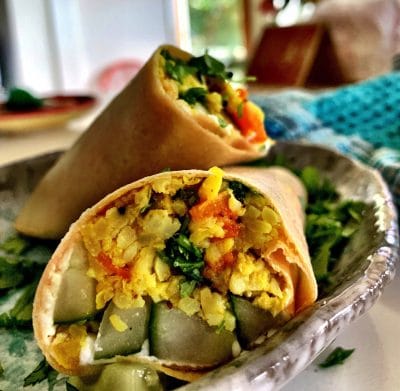Khitchari is a healing food, known in Ayurvedic medicine for it’s balancing qualities, and it can be made to support individual doshas (Ayurvedic body type) or, like the recipe I’m sharing here, suitable for all doshas.
It is a super simple dish to make, and is popular in India as a healing and nourishing food, something you might typically eat if you are unwell or need to build yourself strong again, and a comfort food – maybe India’s version of chicken noodle soup?!

Get all your ingredients together – mise en place – before you start cooking as the spices won’t take long to burn so you want to have everything to hand all ready to go!
The nourishment from this uncomplicated dish, has more than one benefit. It is easy to digest for starters. The mooing dal and the rice are gentle on the tummy and the spices help to balance out what is needed in the digestive system in order to eliminate toxins and also absorb and assimilate the nutrients from our food. They also make it taste mighty fine!
I don’t use onions or garlic here, nor in most dishes – they’re a ‘sometimes food’ for me. But to keep it a sattvic dish, meaning balanced, clean and easy to digest, and to flavour in favour of the former, I use asafoetida instead. I did a separate post on asafoetida or hing, a long time ago, you can click here to read it, if you like.
The rice and moong dal also provide all the amino acids that are required to form an essential (body cannot produce on it’s own) complete protein, and this makes way for stable blood sugar levels, supporting us with the physical and mental energy we need to get on with life!
I recently made it again, after a long time, and thought it would be a good one to share, considering it’s simplicity and it’s benefits.
I usually make up a big batch and freeze some, and eat some. As it is also considered a detoxifying food – the astringency of the moong dal is said to create a natural and GENTLE pulling action that helps to loosen up toxic build up from the intestinal lining – I would usually eat it a few days in a row, in order to stimulate those detoxification effects.

But I just like the damn thing. If you’re not bothered about following the Ayurvedic side of things, you can just eat it any ol’ way you like! I often roast vegetables and add them through the khitchari to make it a little more exciting, and it’s lovely served with a raita or chutney. You can eat it as a side, sling it through a salad, squish it into a wrap, or slop it in your soup! It’s versatile, warming and comforting, and knowing it’s good for me keeps my heart-mind happy too!

Here’s how I make it:
Ingredients:
1 cup moong dal, rinsed well and soaked for at least 6 hours
1 cup basmati rice, rinsed well and soaked for at least six hours
2 teaspoons cumin seeds
1 tablespoon coriander seeds
1 tablespoon coconut oil (or traditionally, ghee)
1 tablespoon mustard seeds
2 tablespoons fresh ginger chopped roughly
1 tablespoon fresh red chilli
1 teaspoon turmeric
1 teaspoon garam masala
1/2 teaspoon of asafoetida
1 teaspoon freshly ground black pepper
1 teaspoon celtic sea salt
2 cups of hot water
Fresh coriander for sprinkling
Method:
- Rinse the rice and moon dal well a few times then soak (separately) in bowls. I add about twice the amount of water to grain, so they are well covered and have some room for expanding, then add a good squeeze of lemon juice, stir well, and cover. Leave for 6-8 hours to soak.
- Dry roast the cumin and coriander seeds in a heavy based pan ( I use a large heavy-based casserole pan) over a medium heat until you raise that beautiful spicy aroma and they have darkened in colour.
- Remove the seeds from the pan and grind in a pestle and mortar.
- Heat the coconut oil in the same pan and when hot, but not smoking, add the mustard seeds and fry for the short time it takes them to pop (don’t let them burn!)
- Add the ginger and chilli and fry for a few minutes
- Add the roasted cumin and coriander, turmeric, garam masala, asafoetida, salt and pepper and fry, stirring gently for a couple more minutes
- Drain and rinse one last time the soaked rice and moong dal, then add them to the pan with the spices, stir it all around gently and then add the hot water, slowly stirring all the while.
- When well combined, put a lid on the pan and bring to a gentle boil, then reduce the heat and let it simmer for about 20-25 minutes, or until the dal and rice are cooked, adding more water along the way if required.
Serve it warm with chopped fresh coriander on top and a drizzle of coconut or olive oil (or ghee if not plant-based). (You can eat it cold too if you like – I do!)
